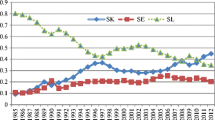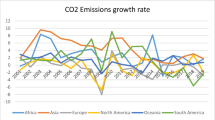Abstract
This paper identifies the determinants of energy productivity based on a basic economic growth model. Using panel data including 29 provinces from 1995 to 2007, we find that energy productivity is negatively associated with the industry sector share in GDP and the state-owned sector share in GDP, and is positively associated with the electricity share in energy consumption. In addition, we find that there exists a big gap of energy efficiency among eastern, middle and western region in China. Our results suggest that we should induce the industry development structure from the industrial sector to service sector, prompt the reform of state-owned enterprises, as well as improve the energy consumption structure dominated by coal to diversified cleaning energy.
摘要
通过对增长模型的分解和相关文献, 讨论能源生产率的影响因素。 在此基 础上利用中国大陆29 省的1995–2007年面板数据, 对各影响因素进行了实证分析。 结果表明: 中国东、 中、 西部地区之间存在显著的能源效率差异, 工业经济比重和国有经济比重同能源生产率之间存在显著负相关, 而能源结构的改善可以促进能源生产率的提升, 但是劳均资本结构和技术水平影响并不显著。
Similar content being viewed by others
References
Chien T, Hu J L (2007). Renewable energy and macroeconomic efficiency of OECD and non-OECD economies. Energy Policy, 35: 3606–3615
Fisher-vanden K, Jefferson G H, Liu H, Tao Q (2004). What is driving China’s decline in energy intensity? Resource and Energy Economics, 26: 77–97
Fisher-vanden K, Jefferson G H, Ma J K, Xu J Y (2006). Technology development and energy productivity in China. Energy Economics, 28: 690–705
Garbaccio R F, Ho M S, Jorgenson D W (1999). Why has the energy-output ratio fallen in China? Energy Journal, 20: 63–92
Greening L A, Greene D L, Difiglio C (2000). Energy efficiency and consumption—the rebound effect—a survey. Energy Policy, 28: 389–401
Hu Xiao (2004). Growing demand, inefficiency blamed for China’s energy shortage. http://www.chinadaily.com.cn/english/doc/2004-06/14/content_339264.htm
International Energy Agency (2007). World Energy Outlook 2007—China and India Insights. Paris: OECD Press
Jefferson G H, Su J (2006). Privatization and restructuring in China: Evidence from shareholding ownership, 1995–2001. Journal of Comparative Economics, 34:146–166
Liao H, Fan Y, Wei Y M (2007). What induced China’s energy intensity to fluctuate: 1997–2006? Energy Policy, 35: 4640–4649
Lin X, Polenske K (1995). Input-output anatomy of China’s energy demand change, 1981–1987. Economic Systems Research, (7): 67–84
Ma C, Stern D I (2008). China’s changing energy intensity trend: A decomposition analysis. Energy Economics, 30: 1037–1053
Rasche R H, Tatom J A (1977). Energy resources and potential GNP. Federal Reserve Bank of St. Louis Review, 59(6): 10–24
Rawski T G (2001). What is happening to China’s GDP statistics? China Economic Review, 12: 347–354
Sinton J E, Fridley D G (2000). What goes up: Recent trends in China’s energy consumption. Energy Policy, 28: 671–687
Sinton J E, Levine M D (1994). Changing energy intensity in Chinese industry: The relatively importance of structural shift and intensity change. Energy Policy, 22: 239–255
Zhang J, Wu G Y, Zhang J P (2007). Estimating China’s provincial capital Stock. Working Paper Series, China Center for Economic Studies, Fudan University
Zhang Z X (2003). Why did the energy intensity fall in China’s industrial sector in the 1990s? The relative importance of structural change and intensity change. Energy Economics, 25: 625–638
刘 伟, 李 绍荣 (Liu Wei, Li Shaorong) (2001). 所有制变化与经济增长和要素效率提升 (The ownership change and the economic growth and upgrading of factors efficiency). 经济研究, (1): 3–9
国家统计局 (National Bureau of Statistics) (1998). 中国能源统计年鉴 (1991–1996) (China Energy Statistical Yearbook (1991–1996)). 北京: 中国统计出版社
国家统计局 (National Bureau of Statistics) (2000). 中国能源统计年鉴 (China Energy Statistical Yearbook (1997–1999)). 北京: 中国统计出版社
国家统计局 (National Bureau of Statistics) (2004). 中国能源统计年鉴 (2000–2002) (China Energy Statistical Yearbook (2000–2002)). 北京: 中国统计出版社
国家统计局 (National Bureau of Statistics) (2007). 2006 年能源利用公告 (Bulletin of energy intensity in 2006). http://www.stats.gov.cn/tjgb/qttjgb/qgqttjgb/t20070712_402417255.htm
国家统计局 (National Bureau of Statistics) (2008). 中国能源统计年鉴 (China Energy Statistical Yearbook 2007). 北京: 中国统计出版社
国家统计局 (National Bureau of Statistics). 中国统计年鉴 (1996–2007) (China Statistical Yearbook: 1996–2007). 北京: 中国统计出版社
Author information
Authors and Affiliations
Corresponding author
About this article
Cite this article
Wei, C., Shen, Mh. What is the driving force of the energy productivity? Evidence from China. Front. Econ. China 4, 265–273 (2009). https://doi.org/10.1007/s11459-009-0015-2
Received:
Published:
Issue Date:
DOI: https://doi.org/10.1007/s11459-009-0015-2




